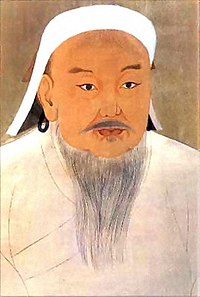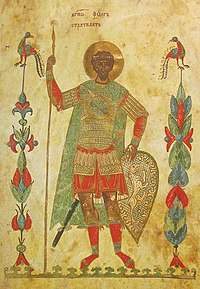Descent from Genghis Khan
Descent from Genghis Khan is traceable primarily in Central Asia, Azerbaijan and some parts of Turkey. His four sons and other immediate descendants are famous by names and by deeds. Later Asian potentates attempted to claim such descent even with flimsy grounds. In the 14th century, valid sources (heavily dependent on Rashid al-Din and other Arabic historians) all but dry up. With the recent popularity of genealogical DNA testing, a wider circle of people started to claim descent from the great conqueror.

The paternity of Jochi
- See also: Family tree of Genghis Khan
The first and foremost problem is the paternity of Genghis's eldest son, Jochi, whose recorded progeny is far more copious than that of Ogedei, Chagatai, and Tolui, taken together. The name of Jochi is translated as "(Unexpected) Guest". The Secret History of the Mongols relates that the boy was sent to Genghis by Chilger, who had kidnapped and raped his favourite wife, keeping her in captivity for about a year. According to the Secret History, the brothers of Jochi expressed doubts as to his paternity, but these were refuted by Genghis himself.[1]
Modern historians speculate that Jochi's disputed paternity was the reason for his eventual estrangement from his father and for the fact that his descendants never succeeded to the imperial throne. On the other hand, Genghis always treated Jochi as his first son, while the failure of the Jochid succession may be explained by Jochi's premature death (which may have excluded his posterity from succession).
Another important consideration is that Genghis's descendants intermarried frequently. For instance, the Jochids took wives from the Ilkhan dynasty of Persia, whose progenitor was Hulagu Khan. As a consequence, it is likely that many Jochids should have had other sons of Genghis Khan among their matrilineal ancestors.
Asian dynasties

Among the Asian dynasties descended from Genghis Khan were the Yuan Dynasty of China, the Ilkhanids of Persia, the Jochids of the Golden Horde, the Shaybanids of Siberia, and the Astrakhanids of Central Asia. As a rule, the Genghisid descent was crucial in Tatar politics. For instance, Mamai had to exercise his authority through a succession of puppet khans but could not assume the title of khan himself because he was not of the Genghisid lineage.
Timur Lenk, the founder of the Timurid Dynasty, claimed to be a descendant from Genghis Khan. While there is no clear evidence for his own descent, he associated himself with the family of Chagatai Khan through marriage. He also never assumed the title "Khan" for himself, but employed two members of the Chagatai clan as formal heads of state. The Mughal Dynasty of India descended from Timur through Babur and from Genghis Khan through Babur's mother.
At a later period, Tatar potentates of Genghisid stock included the khans of Qazan and Qasim (notably a Russian tsar, Simeon Bekbulatovich) and the Giray dynasty, which ruled the Khanate of Crimea until 1783.[2]
As the Russian Empire annexed Turkic polities, their Genghisid rulers frequently entered the Russian service. For instance, Kuchum's descendants became Russified as the Tsarevichs of Siberia. Descendants of the Kyrgyz khans assumed in Russia the name of Princes Valikhanov, while the sons of one Kalmyk khan became known as Princes Dondukov. All these families asserted their Genghisid lineage. The only extant family of this group is the House of Giray, whose members left Soviet Russia for the United States and United Kingdom, where they run Giray Design Company. The Girays are the only living people whose patrilineal descent from Genghis Khan is reasonably certain.
Russian gateways
After the Mongol invasion of Russia, the Rurikid rulers of Russian principalities and the Bagration kings of Georgia were eager to obtain political advantages for themselves and their countries by marrying into the House of Genghis. Alexander Nevsky was adopted by Batu Khan as his son. Alexander's grandson Yury of Moscow married a sister of Uzbeg Khan. On the other hand, petty Mongol princelings of Genghisid stock sometimes settled in Russia. For instance, Berke's nephew adopted the Christian name Peter and founded St. Peter's Monastery in Rostov, where his descendants were long prominent as boyars.[3]

The issue of three Russian-Mongol marriages may be traced down to the present. The most famous was the marriage of St. Fyodor the Black, later proclaimed a patron saint of Yaroslavl, to a daughter of the Mongol khan Mengu-Timur.[4] Fyodor's relations with the khan were idyllic: he spent more time in the Horde (where he was given extensive possessions) than in his capital. Male-line descendants of Fyodor's marriage to the Tatar princess include all the later rulers of Yaroslavl and two dozens princely families (such as the Shakhovskoy, Lvov, or Prozorovsky, among others), which passed Genghis genes to other aristocratic families of Russia.
Prince Gleb of Beloozero, a grandson of Konstantin of Russia, was another Rurikid prince influential at the Mongol court. Gleb married the only daughter of Khan Sartaq. From this marriage descends the House of Belozersk, whose scions include Princes Ukhtomsky and Beloselsky-Belozersky.
The most problematic is the marriage of Narimantas, the second son of Gediminas of Lithuania, to Toqta's daughter. The earliest source for this marriage is the "Jagiellonian genealogy", compiled in the 18th-century from Ruthenian chronicles by one Joannes Werner. While the marriage is not utterly impossible (Narimantas spent several years in the Horde), there are no extant chronicles which mention Narimantas' wife. This highly uncertain gateway derives particular interest from the fact that the Galitzine, Khovansky and Kurakin princely families are Narimantas' agnatic descendants.[5]
Basaraba
The Genghisid descent of the Russian tsars or kings of Georgia cannot be reconstructed from extant documentary evidence. The possibility of such a descent for Western European royalty is even less realistic. Nevertheless, Western genealogists have tried to find a genealogical route linking Genghis Khan with Queen Elizabeth II.
The most popular route is based on the House of Basarab of Wallachian Princes, which today forms southern Romania. The first attested ancestor of the Basarab princes was Thocomerius. There are several theories as to his origin. Some genealogists identify Thocomerius with a Bulgarian boyar named Tihomir (from the Slavic roots for "calm" and "peace"). However many suggest it is a Turkic name (the scholar László Rásonyi-Nagy suggested "basar" - ruling + "aba" - father). Scholars such as Aurel Decei and Neagu Djuvara argue it was a Cuman name, being similar with Toctomerius, a Cuman name mentioned in the the Russian chronicles. Stelian Brezeanu argued however the name is Pecheneg being attested in Transylvania since the 13th century. Another theory is that his real name was Toq-Timur, and that he was a son or grandson of Batu Khan, Jochi's son.
Some descendants of the Basarabs moved to neighboring Hungary and Transylvania, and it has been quite convincingly argued that countess Claudine von Rhedey of the Aba Dynasty decending from King Samuel Aba is also a descendant of the Basarab rulers. This makes Queen Mary, who is the grandmother of Queen Elizabeth II, a descendant of Thocomerius-Tikhomir-Toqtimur.
DNA evidence of patrilineal descent
Zerjal et al [2003] [6] identified a Y-chromosomal lineage present in about 8% of the men in a large region of Asia (about 0.5% of the men in the world). The paper suggests that the pattern of variation within the lineage is consistent with a hypothesis that it originated in Mongolia about 1,000 years ago. Such a spread would be too rapid to have occurred by diffusion, and must therefore be the result of selection. The authors propose that the lineage is carried by likely male-line descendants of Genghis Khan and his close male relatives, and that it has spread through social selection.
According to Family Tree DNA, Genghis Khan is believed to have belonged to Haplogroup C3.[7]
The 25 Marker Y-DNA Profile of Genghis Khan released by Family Tree DNA is:[7]
Popular culture
In The Hitchhiker's Guide to the Galaxy, the motorway contractor Mr. Prosser is (unknown to himself) a direct patrilineal descendant of Genghis Khan. This manifests itself in a predilection for little fur hats, a desire to have axes hanging above his front door, and occasional visions of screaming Mongol hordes.
Notes and references
- ^ In one passage, Chagatai refers to Jochi as "bastard" (254, though the true meaning of the Mongol term is obscure). To this, Genghis Khan responds: "How dare you talk about Jochi like this? Is not he the eldest of my heirs? That I never heard such wicked words again!" (255). All in all, Genghis Khan pronounces the words "Jochi is my eldest son" thrice (210, 242, 254).
- ^ According to some scholars, the Girays were regarded as the second family of the Ottoman Empire after the House of Ottoman: "If Rome and Byzantium represented two of the three international traditions of imperial legitimacy, the blood of Genghis Khan was the third... If ever the Ottomans became extinct, it was understood that the Genghizid Girays would succeed them" (Sebag Montefiore. Prince of Princes: The Life of Potemkin. London, 2000).
- ^ See the medieval life of St. Peter of the Horde and records of the Petrovsky Monastery.
- ^ Later sources indicate that Fyodor's father-in-law was Nogai and his mother-in-law was one of Nogai's wives, whose father was Emperor Michael VIII.
- ^ Another family descending from Narimont were Princes Korecki, whose male line failed in the 17th century. Their cognatic descendants comprise a large part of the Polish aristocracy.
- ^ Zerjal et. al, The Genetic Legacy of the Mongols (PDF), American Journal of Human Genetics, 2003.
- ^ a b Matching Genghis Khan
